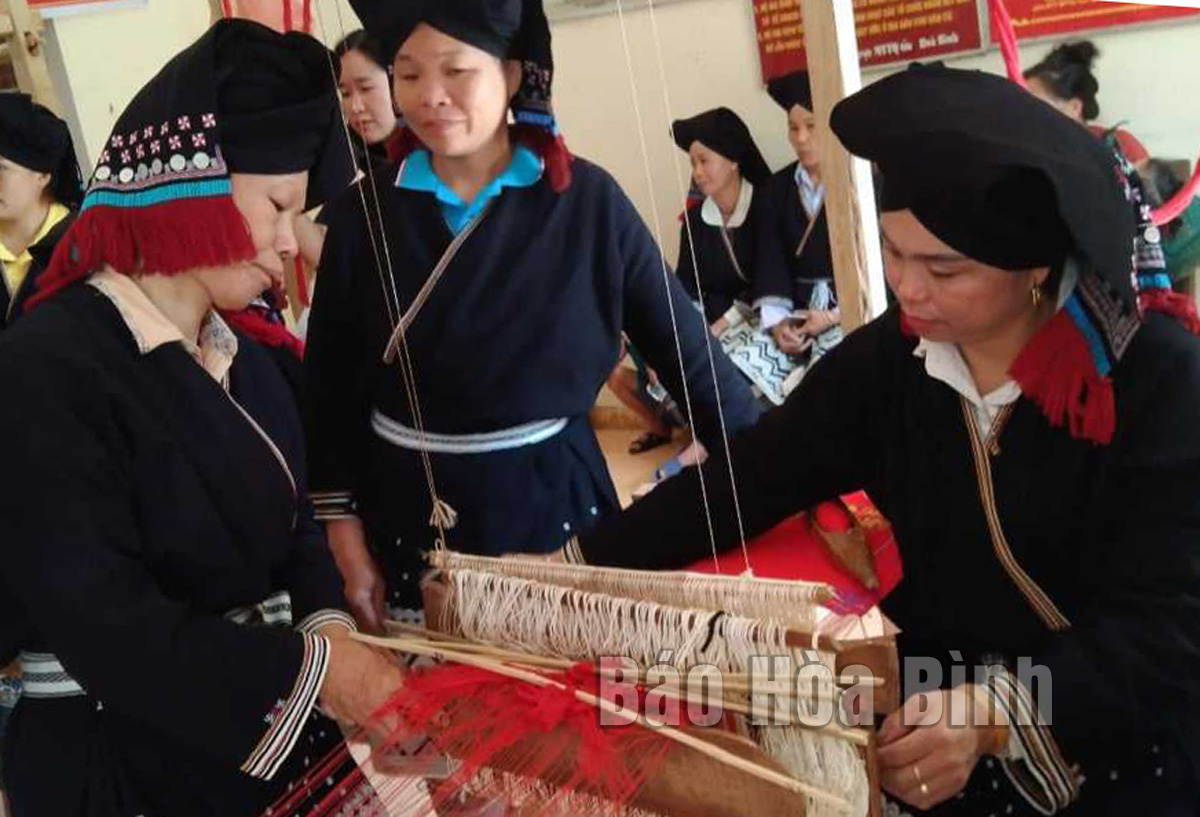
(HBO) - Da Bac, the most difficult highland district of Hoa Binh, is home to over 59,000 people, with ethnic minorities accounting for nearly 90% of the population. Implementing national target programmes, the district has established a steering committee to assign tasks and plan the allocation of fundings for various local projects.

Women in Toan Son commune, Da Bac, learn to revive the traditional weaving craft of the Dao people.
The implementation of projects under the national target programmes has so far brought about positive changes to the lives of local people. The state's investment in infrastructure such as electricity, roads, schools, and medical stations have generated driving forces for the district's socio-economic development.
Bui Thi Chi from Ke hamlet, Hien Luong commune, said: "In the past, my children had to work far away. Since the state supported us in running homestay services, my family has focused on investment and learned from experiences to build our Huu Thao homestay. My children no longer have to work away from home, and our family secures a stable income. Tourism also contributes to preserving the local culture."
According to Luong Van Vinh, head of Trung Tam hamlet, Trung Thanh commune, allowed by the authorities, the Hoa Binh Agriculture Cooperative has signed a 20-year contract to supply raw materials to An Phuoc Group's cotton and yarn factory, which is located in Thach Thanh district, Thanh Hoa province. The cooperative chose the Trung Thanh to cultivate ramie. After two years of implementation, the plant has grown well, with many local households switching from less productive crops to ramie cultivation for more stable income.
Over the recent years, the state's investment programmes and projects in Da Bac have been done timely and effective, with their set targets achieved and overfulfilled. The average per capita income increased from 29.5 million VND (1,243 USD) in 2020 to 37.5 million VND in 2022; the poverty rate decreased from 41.56% in 2021 to 34.94% in 2022; the rate of trained labours reached 61.78% in 2022; and the production value rose from 7.14% in 2021 to 9.2% in 2022. The economic structure shifted in the right direction, with agro-forestry-fisheries accounting for 35.2%, industry-handicraft-construction 21.1%, and trade-tourism-services at 43.7%.
Currently, operating in the district are over 120 businesses and 44 agricultural cooperatives. Industrial-oriented farming models are gradually replacing small-scale methods, while high-value economic goods have been produced on a broader scale./.
Hoa Binh province is undergoing a dynamic transformation amid Vietnam’s national digital transition. Building on Poliburo’s Resolution No. 57-NQ/TW on breakthroughs in science, technology, innovation, and national digital transformation, the province has rolled out a wide range of practical action plans. A standout initiative is the "Digital Literacy for All” movement, an effort to ensure that no one is left behind in the digital era.
Hoa Binh province is undergoing a dynamic transformation in the wake of the national digital transformation movement. Building on Resolution No. 57-NQ/TW of the Politburo on breakthroughs in science, technology, innovation, and national digital transformation, the province has implemented a wide range of practical action plans. A standout initiative is the "Digital Literacy for All” movement ambitious effort to ensure that no one is left behind in the digital age.
With a spirit of unity and proactive problem-solving, the Party Committee, the government and the people of Dong Lai Commune (Tan Lac District) have made great strides in implementing the resolutions of the 24th Party Congress of the commune for the 2020 - 2025 term. Focusing on leadership and practical actions, the commune has brought the Party’s resolutions into daily life, creating strong impacts and pushing the local development forward.
Amid the nationwide push for digital transformation, young people in Hoa Binh Province are stepping up as dynamic pioneers, applying technology to enhance Youth Union operations and expand the reach of youth-led initiatives. Through creativity and adaptability, Youth Union organizations at all levels have introduced a series of practical solutions, contributing to modern governance and community development.
In recent years, An Nghia commune, located in Lac Son district, has stepped up administrative reform, focusing on improving the quality and efficiency of its single-window service unit for receiving and processing administrative procedures. These improvements have helped create favourable conditions for local residents and organisations to handle administrative procedures, contributing to the commune’s broader socio-economic development.
The Prime Minister-approved master plan to develop the multi-use value of forests ecosystems through 2030, with a vision to 2050, aims to improve the management and sustainable use of forest resources, create jobs, increase incomes, and improve the living standards of ethnic minorities, people in mountainous and remote areas, forest workers and those living near forests.



